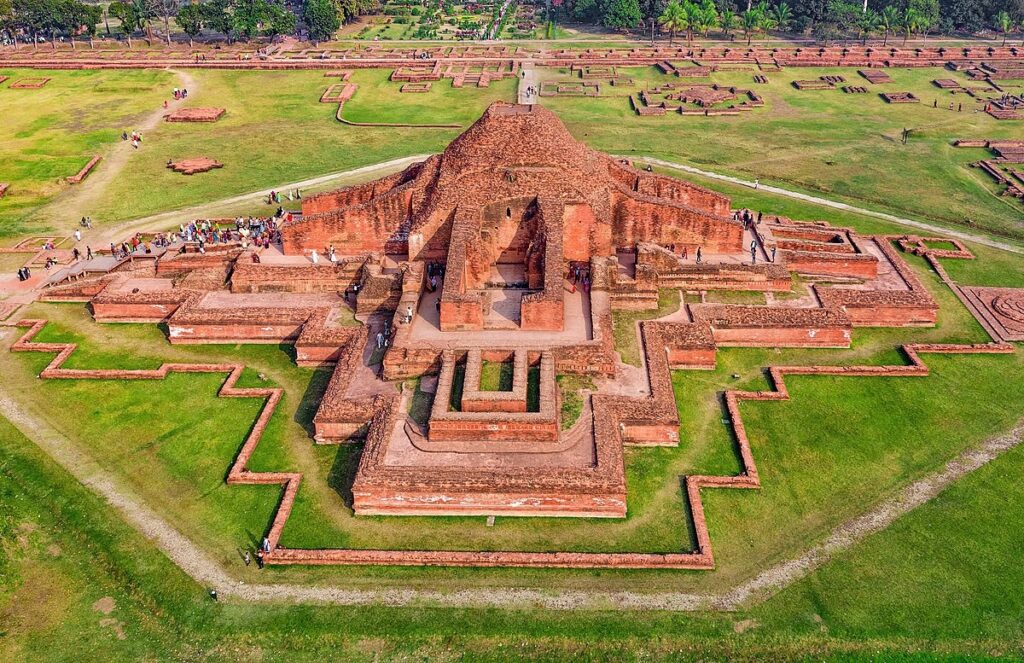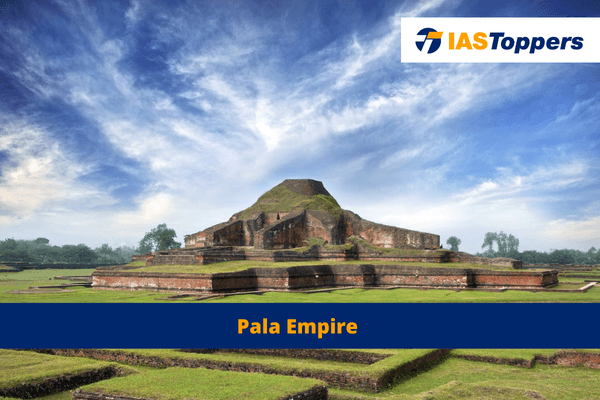Pala Art and Architecture continues to influence many modern buildings of Bangladesh, Bihar, Odisha and West Bengal. Their main religion Buddhism has influenced many of this art and architecture. In this article, you will learn definition, features of Pala school of art, pala art and architecture, religion under Pala empire, Literary work & Artists, etc.
This article will provide key insights for GS Paper-I Indian History and Art and culture section of UPSC IAS Exam.
Table of Content
- Relations with other empires of Pala Empire
- Religion under Pala Empire
- Art and Architecture of Palas
- Literary work & Artists
- Conclusion
- Frequently Asked Questions
Relations with other empires of Pala Empire:
- Their empire fostered relations with the Srivijaya Empire, the Tibetan Empire, and the Arab Abbasid Caliphate.
- The presence of Abbasid coinage at Pala archaeological sites and the records of Arab historians highlights that the trade was flourishing and had intellectual connections.
- During Pala rule, Islam made its first appearance in Bengal due to the increased trade between the region and the Middle East.
- The Palas imported their cavalry horses from the foreigners such as the Kambojas.
Religion under Pala Empire:
- They constructed grand temples and monasteries, including the Somapura Mahavihara.
- They had supported renowned educational institutions like Nalanda and Vikramashila.
- The Palas continued to patronize Shaivism.
- The epigraphic evidence suggests that Mahipala I and Nayapala were initiated as Shaivites by their royal preceptors.
- Devapala built a temple dedicated to Shiva’s consort whereas Mahipala had patronized a Shaivite monastery.
- Bhagalpur inscription of Narayanapala suggests that he built several Shiva temples, and records his grant of a village to Pashupatas.
Art and Architecture of Palas:
Sculptures:
- The Pala school of sculptural art was notable due to the artistic genius of the Bengal sculptors.
- Their architecture was influenced by the Gupta art.
- Deity figures were more rigid in posture, with multiple arms, and standing with straight legs close together.
- Thefigures used to have heavy jewellery and displayed various mudras.
- The temple images used to have a slab with a main figure and surrounded by smaller attendant figures in tribhanga poses.
Monasteries:
- The Somapura Mahavihara is a World Heritage Site in present-day Bangladesh.
- The Somapura Mahavihara is a monastery with 177 cells, numerous stupas, temples and many other ancillary buildings.
- Vikramashila, Odantapuri, and Jagaddala were some of the gigantic vihara structures that resembled a fort.
- The art of Bihar and Bengal during the Pala dynasties later influenced the art of Nepal, Burma, Sri Lanka and Java.
Somapura Mahavihara:

Manuscripts:
- Nalanda and Vikramashila had many arts and manuscripts that illustrated Buddhist themes and images of Vajrayana Buddhistdeities on palm leaves.
- Bothhad workshops for casting of bronze images, which were often carried by foreign students back to their country and influenced their art and culture.
- Astasahasrika Prajnaparamita or the ‘Perfection of Wisdom’ is a manuscript that was written in eight thousand lines during reign of Pala King, Ramapala.
- Astasahasrika Prajnaparamita has six pages of illustrations and wooden covers painted on both sides.
Pala paintings:
- It was characterised by a flowing and sinuous line in subdued colour tones.
Literary work & Artists:
- Under Pala rule, the proto-Bengali language was developed.
- The Gauda riti style of composition was developed during the Pala rule.
- The Pala texts on philosophy include Agama Shastra by Gaudapada, Nyaya Kundali by Sridhar Bhatta and Karmanushthan Paddhati by Bhatta Bhavadeva.
- Ramapala is mentioned in Sandhyakar Nandi’s Ramcharita, which details the Kaivarta peasant rebellion.
- The Buddhist scholar Taranatha has mentioned that Gopala had constructed the Odantapuri monastery.
- Devapala’s court poet was Vajradatta, a Buddhist scholar who wrote the “Lokesvarasataka”.
- An Arab merchant Sulaiman has visited the Pala empire during Devapala’s era and called the dynasty as “Ruhimi or Ruhma Dharma’’.

Texts on medicine include:
- Chakrapani Datta’s: Chikitsa Samgraha, Ayurveda Dipika, Bhanumati, Shabda Chandrika and Dravya Gunasangraha
- Sureshwara’s: Shabda-Pradipa, Vrikkhayurveda and Lohpaddhati
- Vangasena’s: Chikitsa Sarsamgraha
- Gadadhara Vaidya’s: Sushrata
- Jimutavahana’s: Dayabhaga, Vyavohara Matrika and Kalaviveka
Charyapada
- It was the first literary work in the proto-Bengali language.
- Charyapada is the collection of mystical Buddhist poems from the tantric tradition.
- Charyapada was authored by the Mahasiddhas belonging to Bengal, Bihar, Orissa, and Assam.
Santarakshita:
- He was the eminent Buddhist scholar who belonged to Dharmapala’s reign.
- He has founded the philosophical school known as Yogacara-Svatantrika-Madhyamika.
- Svatantrika–Madhyamika united the Madhyamaka tradition of Nagarjuna, the Yogacara tradition of Asanga and the logical thought of Dharmakirti.
Other poets:
- The Buddhist poet Vajradatta has authored Lokesvarashataka in the court of Mahipala I.
Other notable Buddhist scholars:
- Atisha, Santaraksita, Saraha, Tilopa, Bimalamitra, Dansheel, Dansree, Jinamitra, Jnanasrimitra, Manjughosh, Muktimitra, Padmanava, Sambhogabajra, Shantarakshit, Silabhadra, Sugatasree and Virachan.
Conclusion
The Pala arts had flourished due to its distinct styles, as evident in the magnificent sculptures and temple architecture of the time. This period saw the creation of iconic structures like the Mahabodhi Temple in Bodh Gaya, reflecting the dynasty’s commitment to religious and cultural development.
Ref: Source-1
| Other Articles in History & Culture | |
| Hoysala Empire | Hindustani Music |
| Kuchipudi | Medicine in Ancient India |
| Mahayana Buddhism | Great Depression |
FAQs (Frequently Asked Questions)
What was the religion of Pala empire?
The Pala dynasty was Buddhist in religion, but still they fostered other religions well in their ruling period.
What are some of the examples of Pala art and architecture?
The examples of Pala art and architecture includes- Somapura Mahavihara monastery, Vikramashila, Odantapuri, and Jagaddala mong others.
What are some of the exemplary literary works of Pala period?
Agama Shastra by Gaudapada, Nyaya Kundali by Sridhar Bhatta and Karmanushthan Paddhati by Bhatta Bhavadeva Ramcharita by Sandhyakar Nandi among others.


